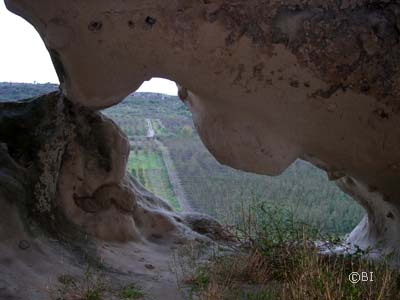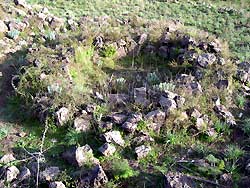The Saracens Caves
 The
“Grotte dei Saraceni” (Saracens Caves or “Grotte della
Saracina” or, according to the historian B. Radice, “dei
Giganti”) are one of the many traces of the existence of
ancient peoples (probably the Sicani) who inhabited our lands. The
“Grotte dei Saraceni” (Saracens Caves or “Grotte della
Saracina” or, according to the historian B. Radice, “dei
Giganti”) are one of the many traces of the existence of
ancient peoples (probably the Sicani) who inhabited our lands. There are spaces dug in the cliff, in an adjacent high sandstone cliff, alongside the Saracens River, a Simeto’s affluent that flows for few kilometres along the 120 state road. Probably they are of prehistoric origin, used in various ages, sometime as rooms and in some cases for military purposes. The Arabs called the zone "Caves of the Flour", or of the Giants, where just in the vicinities, in 1040, they had been defeated, after a ferocious battle, by the Byzantine general George Maniace. This is what writes about these caves Benedict Radice in his Historical Memories of Bronte: «The Maniace caves that the Cavallari calls Caves of the Giants, and the people Saracens Caves, are also remarkable. Of these caves, about a kilometre from the Abby, at the right of the Simeto river, the Cavallari had already given news to the Duke of Lugues believing to be very important. Also the Amari speaks of these caves as of a very ancient work indeed. To these and those of Rocca Calanna the Holm points out: «Ancient caves, he writes, dug by man, can be found between Bronte and Maletto». There are three caves: The one to the Rocca‘s feet is shaped as a corridor, two meters high, and a meter and a half wide.
The second, further up, is divided in two rooms with pillars dug all around. The third one is above; shaped nearly square with three lateral openings, facing South; it is eight metres long and six wide. Rather than graves they must have been rooms for people living there: lookouts where, maybe, in the middle ages, from the sixth to the seventh century, rustic people, dedicated to agriculture and sheep farming, lived for the safety of the countryside; some sort of troglodytes, descending from the ancient Siculi, of which some semi-barbarian groups always remained. The digging work is somewhat similar to the caves of the famous Sperlinga castle". Other similar testimonies to the Saracens Caves, scattered in Bronte’s territory, are the ”burial little cells”, mostly small, where - according to Radice - the corpses were crouched down, with hands stretched over the knees. They appear similar to the cells of the Pantalica necropolis, near Syracuse, rich of funeral furnishings, showing traits of the Sicani’s society of the second period”. ... The Bronte ones, more than to the Siculi should be attributed to the Sicani, first uncouth inhabitants of Sicily.  Interesting and remarkable are “the gruttitti” dug in the Rocca Calanna and the Contura, in the Primaria soprana, under the Colla, in Fontanamurata, Margiogrande, others in Placa Baiana and in Macchiafava. Interesting and remarkable are “the gruttitti” dug in the Rocca Calanna and the Contura, in the Primaria soprana, under the Colla, in Fontanamurata, Margiogrande, others in Placa Baiana and in Macchiafava.
At few kilometres from the Caves, nearly adjacent to the road 120, in district Balze-Mangiasarde, under Maletto can be found further traces of ancient settlings: there can be easily seen a boundary wall (winding for nearly two kilometres) including stone rooms rectangular o circular. They might go from the VI – V century B.C. up to the late Roman period, (III – IV century B.C.). The amount of wall ruins, the perfect basement and raised realization, made with large lava stones, the proximity of other sites of archaeological interest (Tartaraci, Saracens Caves, Santa Venera, etc.) make of this spot an important reason of study and analysis of the Siculi people’s presence in our country side. |